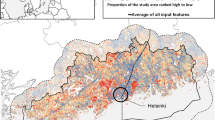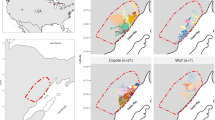Abstract
We introduce a novel approach to building corridors in spatial conservation prioritization. The underlying working principle is the use of a penalty structure in an iterative algorithm used for producing a spatial priority ranking. The penalty term aims to prevent loss or degradation of structural connections, or, equivalently, to promote to a higher rank landscape elements that are required to keep networks connected. The proposed method shows several convenient properties: (1) it does not require a priori specification of habitat patches, end points or related thresholds, (2) it does not rely on resistance coefficients for different habitats, (3) it does not require species targets, and (4) the cost of additional connectivity via corridors can be quantified in terms of habitat quality lost across species. Corridor strength and width parameters control the trade-off between increased structural connectivity via corridors and other considerations relevant to conservation planning. Habitat suitability or dispersal suitability layers used in the analysis can be species specific, thus allowing analysis both in terms of structural and functional connectivity. The proposed method can also be used for targeting habitat restoration, by identifying areas of low habitat quality included in corridors. These methods have been implemented in the Zonation software, and can be applied to large scale and high resolution spatial prioritization, effectively integrating corridor design and spatial conservation prioritization. Since the method operates on novel principles and combines with a large number of features already operational in Zonation, we expect it to be of utility in spatial conservation planning.




Similar content being viewed by others
References
Arponen A, Lehtomaki J, Leppanen J, Tomppo E, Moilanen A (2012) Effects of connectivity and spatial resolution of analyses on conservation prioritization across large extents. Conserv Biol 26(2):294–304
Beier P, Brost B (2010) Use of land facets to plan for climate change: conserving the arenas, not the actors. Conserv Biol 24(3):701–710
Beier P, Spencer W, Baldwin RF, McRae BH (2011) Toward best practices for developing regional connectivity maps. Conserv Biol 25(5):879–892
Bernazzani P, Bradley BA, Opperman JJ (2012) Integrating climate change into habitat conservation plans under the US Endangered Species Act. Environ Manag 49(6):1103–1114
Carroll C, Dunk JR, Moilanen A (2010) Optimizing resiliency of reserve networks to climate change: multispecies conservation planning in the Pacific Northwest, USA. Glob Change Biol 16(3):891–904
Carroll C, McRae BH, Brookes A (2012) Use of linkage mapping and centrality analysis across habitat gradients to conserve connectivity of gray wolf populations in Western North America. Conserv Biol 26(1):78–87
Conchon S, Filliâtre JC (2007) A Persistent Union-Find Data Structure. In: Russo CV, Dreyer D (eds) ML’07 Proceedings of the 2007 ACM workshop on ML, Freiburg, Germany, October 2007. ACM, New York, USA, p 37–46
Conrad JM, Gomes CP, van Hoeve WJ, Sabharwal A, Suter JF (2012) Wildlife corridors as a connected subgraph problem. J Environ Econ Manage 63(1):1–18
Fennell M, Murphy JE, Armstrong C, Gallagher T, Osborne B (2012) Plant Spread Simulator: a model for simulating large-scale directed dispersal processes across heterogeneous environments. Ecol Model 230:1–10
Fuller T, Sarkar S (2006) LQGraph: a software package for optimizing connectivity in conservation planning. Environ Modell Softw 21(5):750–755
Gilbert-Norton L, Wilson R, Stevens JR, Beard KH (2010) A meta-analytic review of corridor effectiveness. Conserv Biol 24(3):660–668
Heller NE, Zavaleta ES (2009) Biodiversity management in the face of climate change: a review of 22 years of recommendations. Biol Conserv 142(1):14–32
Killeen TJ, Solorzano LA (2008) Conservation strategies to mitigate impacts from climate change in Amazonia. Philos Trans R Soc B-Biol Sci 363(1498):1881–1888
Knight K (1989) Unification: a multidisciplinary survey. ACM Comput Surveys 21(1):93–124
Koen EL, Bowman J, Walpole AA (2012) The effect of cost surface parameterization on landscape resistance estimates. Mol Ecol Resour 12(4):686–696
Lagabrielle E, Rouget M, Payet K, Wistebaar N, Durieux L, Baret S, Lombard A, Strasberg D (2009) Identifying and mapping biodiversity processes for conservation planning in islands: a case study in Reunion Island (Western Indian Ocean). Biol Conserv 142(7):1523–1535
Laita A, Kotiaho JS, Mönkkonen M (2011) Graph-theoretic connectivity measures: what do they tell us about connectivity? Landscape Ecol 26(7):951–967
Leathwick J, Moilanen A, Francis M, Elith J, Taylor P, Julian K, Hastie T, Duffy C (2008) Novel methods for the design and evaluation of marine protected areas in offshore waters. Conserv Lett 1(2):91–102
Lehtomäki J, Moilanen A (2013) Methods and workflow for spatial conservation prioritization using Zonation. Environ Modell Softw 47:128–137
Li H, Li D, Li T, Qiao Q, Yang J, Zhang H (2010) Application of least-cost path model to identify a giant panda dispersal corridor network after the Wenchuan earthquake-Case study of Wolong Nature Reserve in China. Ecol Model 221(6):944–952
Lindenmayer DB, Possingham HP, Lacy RC, McCarthy MA, Pope ML (2002) How accurate are population models? Lessons from landscape-scale tests in a fragmented system. Ecol Lett 6(1):41–47
McDonnell MD, Possingham HP, Ball IR, Cousins EA (2002) Mathematical methods for spatially cohesive reserve design. Environ Model Assess 7:107–114
McRae BH, Dickson BG, Keitt TH, Shah VB (2008) Using circuit theory to model connectivity in ecology, evolution, and conservation. Ecology 89:2712–2724
McRae BH, Hall SA, Beier P, Theobald DM (2012) Where to restore ecological connectivity? detecting barriers and quantifying restoration benefits. PLoS One 7(12):e52604
Moilanen A (2007) Landscape Zonation, benefit functions and target-based planning: unifying reserve selection strategies. Biol Conserv 134(4):571–579
Moilanen A, Wintle BA (2007) The boundary-quality penalty: a quantitative method for approximating species responses to fragmentation in reserve selection. Conserv Biol 21(2):355–364
Moilanen A, Franco AMA, Early RI, Fox R, Wintle B, Thomas CD (2005) Prioritizing multiple-use landscapes for conservation: methods for large multi-species planning problems. Proc R Soc B-Biol Sci 272(1575):1885–1891
Moilanen A, Wilson KA, Possingham H (eds) (2009) Spatial conservation prioritization: quantitative methods and computational tools. Oxford University Press, New York
Moilanen A, Leathwick JR, Quinn JM (2011) Spatial prioritization of conservation management. Conserv Lett 4(5):383–393
Moilanen A, Meller L, Leppänen, J, Pouzols FM, Kujala H, Arponen A (2012) Zonation Spatial Conservation Planning Framework and Software. Version 3.1. User Manual. University of Helsinki, Finland. pp. 288
Moilanen A, Anderson BJ, Arponen A, Pouzols FM, Thomas CD (2013) Edge artefacts and lost performance in national versus continental conservation priority areas. Divers Distrib 19(2):171–183
Mönkkonen M, Mutanen M (2003) Occurrence of moths in boreal forest corridors. Conserv Biol 17(2):468–475
Nalle DJ, Arthur JL, Sessions J (2002) Designing compact and contiguous reserve networks with a hybrid heuristic algorithm. For Sci 48(1):59–68
Naujokaitis-Lewis IR, Curtis JM, Arcese P, Rosenfeld J (2009) Sensitivity analyses of spatial population viability analysis models for species at risk and habitat conservation planning. Conserv Biol 23(1):225–229
Nuñez TA, Lawler JJ, McRae BH, Pierce DJ, Krosby MB, Kavanagh DM, Singleton PH, Tewksbury JJ (2013) Connectivity planning to address climate change. Conserv Biol 27(2):407–416
Önal H, Briers RS (2002) Selection of a minimum-boundary reserve network using integer programming. Proc R Soc B-Biol Sci 270:1487–1491
Pinto N, Keitt TH (2009) Beyond the least-cost path: evaluating corridor redundancy using a graph-theoretic approach. Landscape Ecol 24(2):253–266
Pinto N, Keitt T, Wainright M (2012) LORACS: JAVA software for modeling landscape connectivity and matrix permeability. Ecography 35(5):388–392
Rathore CS, Dubey Y, Shrivastava A, Pathak P, Patil V (2012) Opportunities of habitat connectivity for tiger (Panthera tigris) between Kanha and Pench National Parks in Madhya Pradesh, India. PLoS One 7(7):e39996
Rayfield B, Moilanen A, Fortin MJ (2009) Incorporating consumer-resource spatial interactions in reserve design. Ecol Model 220(5):725–733
Roever CL, van Aarde RJ, Leggert K (2013) Functional connectivity within conservation networks: delineating corridors for African elephants. Biol Conserv 157:128–135
Rose NA, Burton PJ (2009) Using bioclimatic envelopes to identify temporal corridors in support of conservation planning in a changing climate. For Ecol Manag 258:S64–S74
Rouget M, Cowling RM, Lombard AT, Knight AT, Graham IHK (2006) Designing large-scale conservation corridors for pattern and process. Conserv Biol 20(2):549–561
Ruckelshaus M, Hartway C, Kareiva P (2003) Assessing the data requirements of spatially explicit dispersal models. Conserv Biol 11(6):1298–1306
Saura S, Torné J (2009) Conefor Sensinode 2.2: a software package for quantifying the importance of habitat patches for landscape connectivity. Environ Modell Softw 24(1):135–139
Soille P (2004) Morphological image analysis: principles and applications, 2nd edn. Springer, Berlin
Theobald DM, Reed SE, Fields K, Soulé M (2012) Connecting natural landscapes using a landscape permeability model to prioritize conservation activities in the United States. Conserv Lett 5(2):123–133
Thomson JR, Moilanen AJ, Vesk PA, Bennett AF, Mac Nally R (2009) Where and when to revegetate: a quantitative method for scheduling landscape reconstruction. Ecol Appl 19(4):817–828
Tischendorf L, Fahrig L (2000) On the usage and measurement of landscape connectivity. Oikos 90(1):7–19
Toteu SF, Anderson JM, de Wit M (2010) ‘Africa Alive Corridors’ Forging a new future for the people of Africa by the people of Africa. J Afr Earth Sci 58(4):692–715
Williams P, Hannah L, Andelman S, Midgley G, Araujo M, Hughes G, Manne L, Martinez-Meyer E, Pearson R (2005) Planning for climate change: identifying minimum-dispersal corridors for the Cape proteaceae. Conserv Biol 19(4):1063–1074
Wintle B, Elith J, Potts JM (2005) Fauna habitat modelling and mapping: a review and case study in the Lower Hunter Central Coast region of NSW. Austral Ecol 30(7):19–38
Acknowledgments
We thank the ERC-StG Grant 260393 (GEDA), the Finnish Ministry of Environment and Natural Heritage Services (Metsähallitus) and the Academy of Finland centre of excellence programme 2012–2017 for support. We thank Johanna Kuusterä for technical assistance. We also thank Andrea Santangeli, Santiago Saura and three anonymous reviewers for their constructive comments and suggestions.
Author information
Authors and Affiliations
Corresponding author
Electronic supplementary material
Below is the link to the electronic supplementary material.
Rights and permissions
About this article
Cite this article
Pouzols, F.M., Moilanen, A. A method for building corridors in spatial conservation prioritization. Landscape Ecol 29, 789–801 (2014). https://doi.org/10.1007/s10980-014-0031-1
Received:
Accepted:
Published:
Issue Date:
DOI: https://doi.org/10.1007/s10980-014-0031-1




